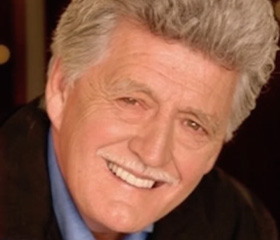If you were in a room filled with theater people and B.H. Barry were in attendance, next to him is where you’d want to be. For there, as I discovered in a recent conversation, you might find out about Errol Flynn’s stunt double or what Nicol Williamson was really like or the advice Alan Bates gave about fame. Mostly, you would learn why, over a 60-year career, Barry became a revered fight director, the role he played for LCT’s production of Camelot.
When asked to explain his expertise Barry, who was born 83 years ago in Staines, 17 miles up the Thames from London, and got his start significantly at the Royal Shakespeare Company, is concise: “I’ve been around a lot so I know a few things.” Chief among them is that choreographing a fight should not involve putting your own personal vision of movement on a stage. “A fight should help tell the story and reveal character,” Barry said. “Not just offer up your own ideas.”
To illustrate that philosophy he mentioned the main fight of Camelot, which involves King Arthur, Lancelot, and the king’s knights. “It is really a series of three mini-fights,” Barry said. “It is a progression, in which we see Guinevere’s feelings about Lancelot and Arthur undergo change. And I think the fights show us that evolution clearly.”
From my schoolboy trips through medieval rooms of museums I knew that swords and armor were heavy – “When a knight got on his horse,” a docent told my fifth-grade class, “it’s a wonder the steed didn’t tip over” – so I asked Barry about the Camelot weaponry. “The swords aren’t realistic,” he replied. “Because you can’t put the actors in serious danger. The weapons are made of aircraft aluminum, and weigh about two pounds each.” He added: “But you have to create the illusion that they’re threatening. We use lighting to make the metal gleam – because glint creates the sense that a sword is lethally sharp.”
Although a fight director helps create the illusion of violence, Barry stresses that a fight director must make the actors feel secure. “This is achieved through the safety precautions I take,” he said. “Among them is the fight warm-up – in which, just before the show, the actors go through the movement of the fights.” Barry, the only fight director to receive a Tony Award, is justifiably proud that during his long career – which includes several films (The Addams Family, Mulan, Glory) and 43 Broadway productions, seven of them Bardic – there have been “only two minor accidents for which I take responsibility. In one, a person walked into a beam offstage and was knocked unconscious. In the other, somebody hit a knee on a step. A pretty good record, I’d say.”
Barry’s confidence derives not from a sense that he always knows best. “I will take a note from anyone,” he said. “From an usher, an assistant stage manager, a stagehand. The stagehands at the Met” – Barry has been fight director on numerous operas – “can be absolutely brutal in their opinions. They have no hesitation in watching a fight and saying, ‘That sucked.’ But I’m not shocked. I trained them to be that honest.”
Barry has trained others in a more formal way: through teaching. He has been an instructor at The Royal Academy of Dramatic Art, Yale, Temple, NYU, and Juilliard. It is through his students that he has helped define the profession of a modern fight director. To get there he himself learned from pre-21st-century practitioners of the craft: the English director Barry Jackson, with whom Barry studied Aikido and stage combat, and Paddy Crean, who among other things was Errol Flynn’s stunt double. “Paddy had an elegant voice,” Barry said. “He loved life, he loved women, and he loved to drink. If I had to sum him up in one word, it would be: panache. I miss that guy so much.”
Barry himself has throwback elegance, but if he can tell you about Nicol Williamson (“a fearless actor but if he’d been drinking watch out”) and Alan Bates (“he gave me a great piece of advice: ‘Never believe your own publicity”) he doesn’t think actors are automatically superior just because they trod the boards with Olivier.
“The truth is that the Camelot group is the best company I’ve ever worked with. So I’m glad that this is my final show.” Yes, it’s true. If a Beaumont production (Macbeth, 1982) was Barry’s first extended Broadway credit, the current Beaumont production will be his last. “I feel I’ve earned my retirement, the right to a little sunshine.”
Indeed.
Brendan Lemon is a freelance journalist in New York.
